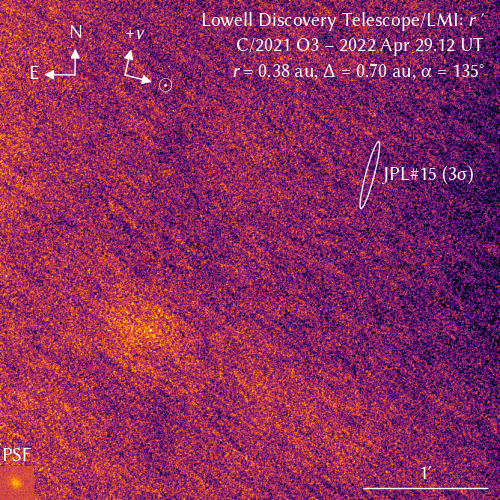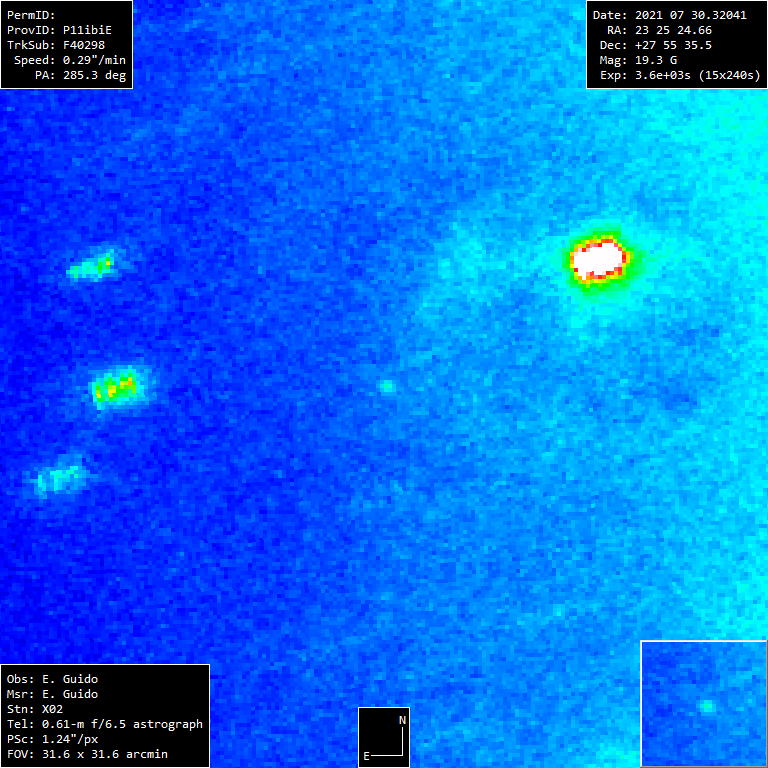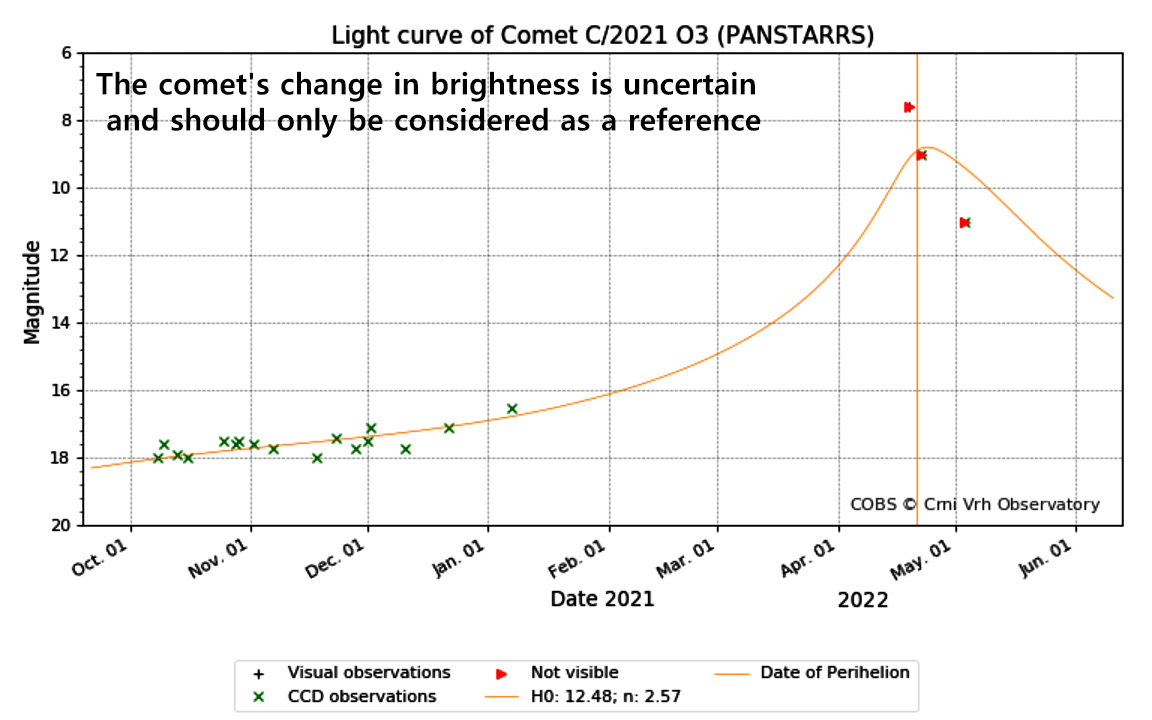Disintegration of Near-Sun Comet C/2021 O3 (PANSTARRS).
태양 근접 혜성 C/2021 O3(PANSTARRS)의 붕괴.
https://www.astronomerstelegram.org/?read=15358
ATel #15358; Qicheng Zhang (Caltech), Quanzhi Ye (U. Maryland/Boston U.), Tony L. Farnham (U. Maryland), Carrie E. Holt (U. Maryland).
on 2 May 2022; 18:49 UT.
Twilight observations conducted with the Lowell Discovery Telescope (LDT) on 2022 April 29 (UT) indicate that comet C/2021 O3 (PANSTARRS) has disintegrated. We used LDT's Large Monolithic Imager to obtain 19 x 1 s exposures of the comet through the r′ filter between 02:50 and 02:54 UT at ~6° altitude where the seeing was ~4″ FWHM. The comet would have been 0.38 au from the Sun, 0.70 au from Earth, and at 135° phase angle during these observations. We accounted for the expected, rapid ~7 arcsec/min motion of the comet by aligning and stacking the calibrated frames on the JPL orbit #15 ephemerides positions. A median stack showing the vicinity of the predicted position, with the formal 3σ uncertainty ellipse and a point spread function (PSF) model derived from a separate stack of a background star labeled, is available here:
https://near.earth/shared/2022/04/ldt_2021o3_20220429.png
While extrapolation of the earlier pre-perihelion brightening trend projected that the comet would have brightened to a magnitude of V ~ r′ ~ 5 by this time, no objects with the expected motion of the comet are visible within the 3σ uncertainty ellipse. The magnitude limit of r′ > 14 for point sources in the stacked image very roughly constrains dust production activity of a comet in this region to Afρ < 10 cm. However, a diffuse glow ~40″ in diameter with an integrated magnitude of r′ ~ 9 is visible above the noise level ~2′ southeast of the JPL position and appears to be co-moving with the JPL orbital solution. The large offset in both the antisunward and negative heliocentric velocity directions together with the lack of any observed nuclear condensation suggests that this feature is a dust cloud or debris field persisting as a remnant from the disintegration of the nucleus, an event likely associated with the comet's close perihelion passage on April 21 at 0.29 au from the Sun. This conclusion lines up with previous reports the comet had fallen below its earlier brightness trend since a few days before perihelion.
These results made use of the Lowell Discovery Telescope (LDT) at Lowell Observatory. Lowell is a private, non-profit institution dedicated to astrophysical research and public appreciation of astronomy and operates the LDT in partnership with Boston University, the University of Maryland, the University of Toledo, Northern Arizona University and Yale University. The University of Maryland observing team consisted of Quanzhi Ye, James Bauer, Michaela Blain, Adeline Gicquel-Brodtke, Tony Farnham, Lori Feaga, Carrie Holt, Michael S. P. Kelley, and Jessica Sunshine.
2022년 4월 29일(UT)에 로웰 발견 망원경(LDT)으로 수행된 황혼 관측에 따르면 혜성 C/2021 O3(PANSTARRS)가 분해된 것으로 나타났습니다. 우리는 LDT(Lowell Discovery Telescope)의 Large Monolithic Imager를 사용하여 시상이 약 4" FWHM이고 약 6° 고도에서 02:50 ~ 02:54 UT 사이에 r′ 필터를 통해 혜성을 19 x 1초 노출을 얻었습니다. 이 혜성은 태양에서 0.38 AU, 지구에서 0.70 AU, 그리고 이 관측 동안 135° 위상각을 가졌을 것입니다. 우리는 JPL 궤도 #15 ephemerides 위치에서 보정된 프레임을 정렬하고 스택하여 혜성의 약 7 arcsec/min의 빠른 움직임을 예상했습니다. 3σ 불확실성 타원과 라벨된 배경 별의 별도 스택에서 유도된 PSF(point spread function) 모델로 예측된 위치 부근을 보여주는 중앙값 스택은 여기서 볼 수 있다:
https://near.earth/shared/2022/04/ldt_2021o3_20220429.png
초기 근일점 밝기 증가 경향의 외삽은 이 시기에 혜성이 V ~ r' ~ 5의 등급으로 밝아졌을 것으로 예상했지만, 3σ 불확실성 타원 내에서 혜성의 예상 움직임을 가진 물체는 볼 수 없었습니다. 누적한 이미지에서 점광원에 대한 r ' > 14 의 등급 제한은 Afρ < 10 cm인 이 영역에서 혜성의 먼지 생성 활동을 매우 대략적으로 제한합니다. 그러나 r' ~ 9의 누적 등급을 가진 직경 ~40″의 확산 광선은 JPL 예상 위치의 남동쪽 약 2' 노이즈 레벨 위에서 볼 수 있으며 JPL 궤도 솔루션과 함께 움직이는 것으로 보입니다. 관측된 핵 응축의 부족과 함께 태양 반대 방향 및 음의 태양 중심 속도 방향 모두에서 큰 옵셋은 이 특징은 4월 21일 태양으로부터 0.29 AU에서 혜성의 가까운 근일점 통과와 관련된 혜성의 붕괴와 관련된 사건인 핵 붕괴의 잔재로 지속되는 먼지 구름 또는 파편 영역임을 암시합니다. 이 결론은 혜성이 근일점 이전 며칠 이후로 초기 밝기 경향 아래로 떨어졌다는 이전 보고서와 일치합니다.
이 결과는 로웰 천문대의 로웰 디스커버리 망원경(LDT)을 사용했습니다. 로웰은 천체 물리학 연구와 천문학에 대한 대중의 이해를 전담하는 사립 비영리 기관이며 보스턴 대학교, 메릴랜드 대학교, 톨레도 대학교, 노던 애리조나 대학교 및 예일 대학교와 협력하여 LDT를 운영합니다. 메릴랜드 대학 관측 팀은 Quanzhi Ye, James Bauer, Michaela Blain, Adeline Gicquel-Brodtke, Tony Farnham, Lori Feaga, Carrie Holt, Michael SP Kelley 및 Jessica Sunshine으로 구성되었습니다.
Image credit: E. Guido/ M. Rocchetto, E. Bryssinck/ M. Fulle, G. Milani/ C. Nassef/ G. Savini/ A. Valvasori, COBS.







댓글